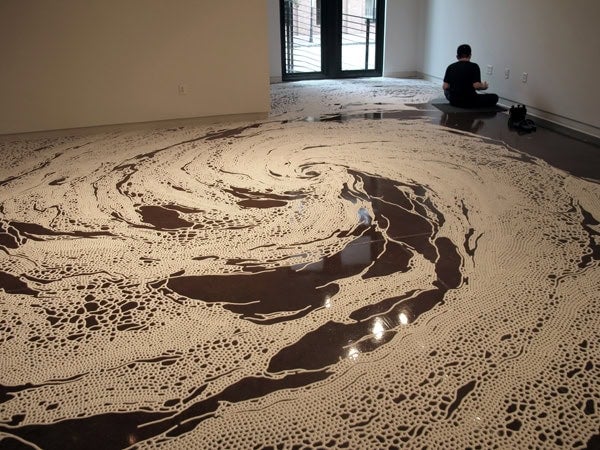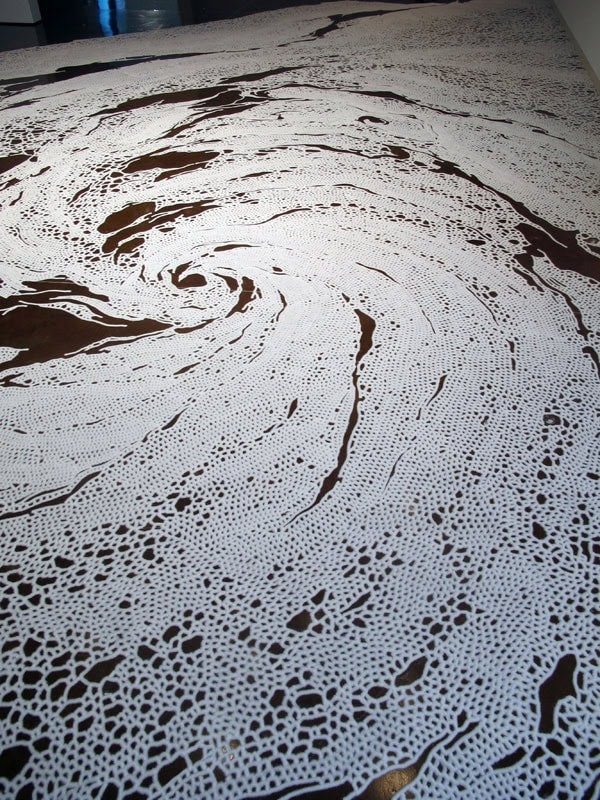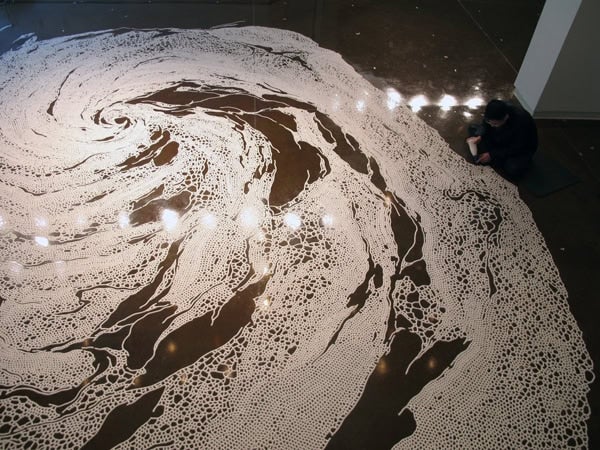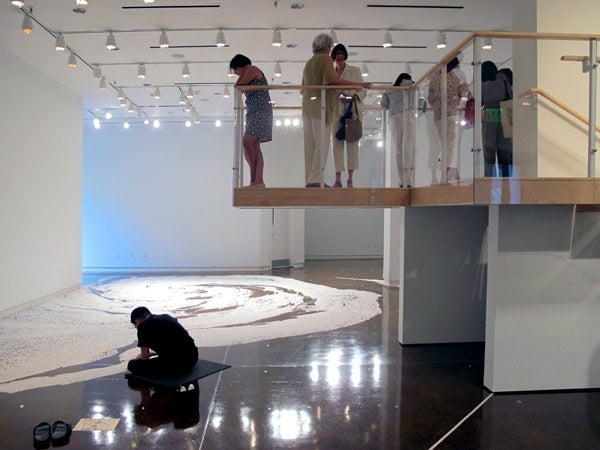
Welcome to the newly revived The Fringe curated by Kristin Juárez. The column now features a rotating roster of writers, many contributing from as far as Los Angeles and Berlin. See the curator’s note below to learn more.
Although Japanese artist Motoi Yamamoto’s work has been exhibited around the world, his work has not been seen widely in the United States. One of his first major solo exhibitions here was a temporary installation created at Charleston, South Carolina’s Halsey Institute of Contemporary Art, which I saw during a visit to the Spoleto Festival in May.
Yamamoto’s large-scale, intricate, temporary sculptures and installations created out of salt are the artist’s way of memorializing his sister, who died at the age of 24 of brain cancer. Yamamoto—who had long used natural materials in his work such as grass, wood and water—chose salt because of its simplicity and purity. Salt is broadly symbolic in Japanese culture—used in funeral ceremonies, placed outside of temples, tossed into the ring before sumo matches, set in a pile at the door of a restaurant as a sign of welcome—a powerful symbol of cleanliness and purity, primarily deriving from salt’s preservative qualities and its historical scarcity in Japan.
Despite these specific connotations and symbolic resonances, salt remains unfastened to any one specific meaning: its color, simplicity, and ubiquity allow for an open-endedness, transparency, and clarity (salt is not technically white, but clear; it appears white when crystals are piled together). Yamamoto refers to the process of creating his installations as “clearing his heart.”
Yamamoto generally creates his salt installations in several types. There are the large sculptural installations which he refers to as “mountains,” large formations often involving several tons of salt taking the form of mountains, towers, staircases, or tunnels. He also frequently creates patterns on the floor, as he did in Charleston.

The Charleston installation took 11 days to create. Yamamoto worked from a rough sketch and used simple table salt from the grocery store. To pour the salt he uses an object from his childhood: his parents ran a bicycle shop, and when Yamamoto first began working with salt, he knew the plastic squeeze bottle used to apply grease to the bicycle parts would be perfect for dispensing salt.
The resulting spiral recalls images from the natural world: eddies or tidal foam, a galaxy, a mountain range or a hurricane seen from above, perhaps even an intricate network of brain cells. The work is tranquil, but it also brings to mind the great energy and devotion required to make it: its delicacy and impermanence are also foremost.
Although the creation of Yamamoto’s work is quite solitary, the dismantling is communal and collaborative, even celebratory. On the day of dismantling, members of the community are invited to scoop up the salt and carry it in small bags to pour it back into the sea. Salt is an integral part of natural processes and, as Yamamoto has explained, could conceivably enter and leave multiple organisms throughout the planet after it leaves the installation. Every grain has both a history and a future.
“What I seek is to capture a frozen moment that cannot be attained through pictures or writings,” Yamamoto is quoted in the exhibition catalog. “What I look for at the end of the act of drawing could be a feeling of touching a precious memory.”
There’s a lovely circularity to the whole process, but also a linearity. The work turns the repeating, anonymous cycles of nature into a narrative, one that momentarily interrupts the enormous, impersonal cycle. He placed it there in memory of his sister, and others come and carry it away. A story is pressed into the process: it’s destroyed and turned into a memory.

It’s clear that Charleston residents responded strongly to Yamamoto’s work. A curious public was invited to visit Yamamoto in the galleries when he was creating his installation during his two-week residency to watch him work. Local restaurants even brought the artist food during the laborious process. Charleston has a long and unfortunate history with hurricanes, and many viewers saw the all-too-familiar pattern of a radar map of a hurricane in the swirling design of Yamamoto’s installation. Charleston is an inspired choice for the setting of Yamamoto’s work: a small community with a strong cultural identity, sense of history, and ties to the sea, which surrounds the city.
The work’s inclusion in an arts festival devoted primarily to performance emphasized the performative and time-based aspects of the work. The 35-year-old Spoleto Festival is deeply embedded in Charleston’s make-up, providing a pre-existing framework for encountering contemporary work and a sense of familiarity and accessibility between artist and viewers. Over 80,00 visitors saw the exhibit, and on July 7, 2012, an enthusiastic crowd of dismantlers spoke to Yamamoto via Skype before scraping the salt back into the Morton’s salt containers it had come from, a process which took about 45 minutes, and carrying it to Charleston Harbor. Writer Amelia Thomson of Charleston City Paper, who participated in the dismantling, wrote, “And with that, we poured the remains of Yamamoto’s exhibit back into the eco-system, confident that it will cycle back into our lives.”
Through his artistic practice, Yamamoto’s private vision becomes communal. It’s perhaps a way of turning despair into grief: grief can involve movement and community, whereas despair does not. Yamamoto has described his artistic practice as “futile but necessary.” It’s a phrase that could describe all artistic practices, but seldom has the process appeared more simple, more moving, more beautiful, and more necessary than in Yamamoto’s work.

About this column:
The Fringe seeks to make greater connection between Atlanta and the art world at large. Now with writers contributing from around the country, the column continues to follow contemporary art that addresses the unique qualities of the natural, built, and social environments. The Fringe will unfold as several collections of articles bound together by a theme.
Andrew Alexander’s article is the first in the collection I have named “Life as Form” after Creative Time’s second annual summit. The correlating exhibition entitled Living As Form combined artists, theorists, curators, and activists to consider how creative projects can restructure relationships between people and the places they live. Similarly, BURNAWAY will reflect on artistic form and public engagement in projects based in Los Angeles, Chicago, New York, Charleston, Berlin, and Atlanta.
—Kristin Juárez




